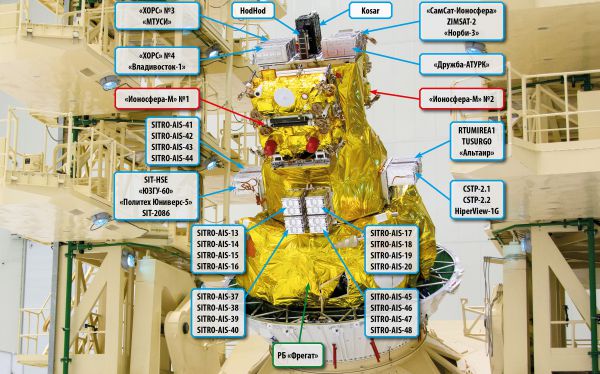A record number of Russian satellites were launched into orbit simultaneously
November 5, 2024
The accompanying payload, consisting of 49 Russian, Russian-Chinese, Russian-Zimbabwean and two Iranian small spacecraft, was delivered to the target orbits and separated from the Fregat upper stage, which was launched today by the Soyuz-2.1b launch vehicle from the Vostochny Cosmodrome.
Taking into account the Ionosfera-M heliogeophysical satellites No. 1 and No. 2 launched into orbit, the simultaneous launch of 51 Russian spacecraft became a record in the history of Russian cosmonautics.
In the interests of the UniverSat program carried out by the Roscosmos State Corporation jointly with the country's higher educational institutions, six CubeSat satellites were delivered into space.
The Norbi-3 satellite with a 6U CubeSat size was developed by the Novosibirsk National Research State University for scientific research.
The Khors-3 and Khors-4 satellites, each 6UXL CubeSat, were created by the Bauman Moscow State Technical University for the purpose of radio occultation sounding of the Earth's atmosphere and ionosphere.
The 6UXL CubeSat MTUCI-1 satellite was created by the Moscow Technical University of Communications and Informatics for the purpose of studying "space weather".
The 3U CubeSat SamSat-Ionosphere satellite was developed by the Samara National Research University named after Academician S.P. Korolev for studying the upper ionosphere, plasma state, and magnetic field of the Earth.
The 8U CubeSat Vladivostok-1 satellite was created by the Far Eastern Federal University for the purpose of measuring radiation in near-Earth space.
In addition, the Russian-Chinese Druzhba ATURK 12U CubeSat spacecraft, made by Amur State University and Harbin Polytechnic University, and the Russian-Zimbabwean ZimSat-2, made by Southwest State University and the National Geospatial and Space Agency of Zimbabwe, with the tasks of remote sensing of the Earth, were launched into orbit.
As part of the Space-Pi project, organized by the Foundation for Assistance to Innovations with the support of Roscosmos, Russian universities and high-tech companies, 16 CubeSat satellites were delivered into space.
The Altair 6U CubeSat satellite was developed by the Skobeltsyn Research Institute of Nuclear Physics of the Lomonosov Moscow State University for radiation monitoring of near-Earth space.
The Colibri-S 3U CubeSat and HyperView-1G 6U CubeSat satellites were created by Samara National Research University named after Academician S.P. Korolev for the purpose of remote sensing of the Earth.
The Gorizont 3U CubeSat satellite was created by the Baltic State Technical University "Voenmech" named after D.F. Ustinov for the purpose of testing experimental developments of students.
The Nokhcho 3U CubeSat satellite was developed by the Chechen State University named after A.A. Kadyrov for measuring the Earth's magnetic field.
The YUZGU-60 3U CubeSat satellite was created by the South-West State University for the purpose of testing radiation protection in outer space.
The Polytech Universe-4 and Polytech Universe-5 3U CubeSats were each created by Peter the Great St. Petersburg Polytechnic University for the purpose of remote sensing of the Earth.
The TUSUR GO 3U CubeSat was developed by Tomsk State University of Control Systems and Radioelectronics to test inter-satellite communications.
The SIT-2086 3U CubeSat was created by Moscow School No. 2086 to test Internet of Things technologies.
The Vizard-ion 3U CubeSat was developed by MSU-Standard to study the ionosphere.
The RTU MIREA1 3U CubeSat was developed by MIREA Russian Technological University to study the ionosphere.
The ArcticSat-1 3U CubeSat was created by the Northern (Arctic) Federal University named after M.V. Lomonosov to study the influence of "space weather" factors on spacecraft systems in polar regions.
The SIT-HSE 3U CubeSat satellite of the Saint Petersburg State University of Telecommunications named after prof. M.A. Bonch-Bruevich was created to test the Internet of Things technology based on the LORA protocol, as well as to conduct Earth surveys.
The Mordovia satellite for measuring the noise level of the near-Earth space and the Ruzayevka-390 satellite for testing Internet of Things technologies, each 3U CubeSat, were developed by schoolchildren and students of the Republic of Mordovia.
Also, 24 SITRO-AIS automatic identification system spacecraft, each 3U CubeSat, were launched into orbit by the Sputnix company for tracking sea vessels.
In the interests of the Special Technology Center, the CSTP-2.11 12U CubeSat, CSTP-2.1 and CSTP-2.2 3U CubeSat satellites were delivered into space for the purpose of conducting scientific research.
Finally, Hodhod 3U Cubesat satellites launched into orbit to test Internet of Things technologies
Last Articles
December 29, 2025
Glavkosmos ensured the preparation and launch of 48 small rideshare spacecraft with Aist-2T mission
December 26, 2025
Preparations for the launch of two Aist-2T spacecraft and small rideshare satellites are being completed in Vostochny
December 23, 2025
Payload unit of the rocket for the Aist-2T No. 1 and No. 2 and 50 small satellites launch assembled at Vostochny
Articles Archive
2025
2024
2023
2022
2021
2020
2019
2018
2017

